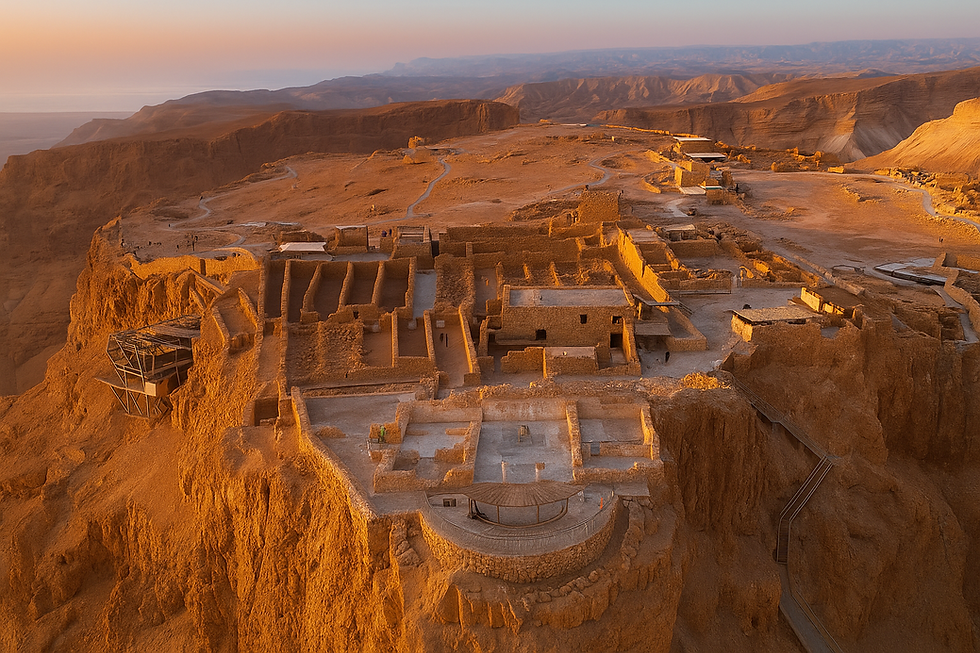Masada – Fortress of Freedom and Memory
- Tour-Eat
- Feb 14, 2024
- 4 min read
A Desert Fortress Above Time
High above the stark Judean Desert, overlooking the shimmering waters of the Dead Sea, rises Masada – a mountain plateau that has become one of Israel’s most powerful symbols. Its dramatic history, stunning desert views, and archaeological treasures draw over a million visitors each year. Masada is more than ruins; it is a story of power, survival, and the human spirit.
Herod’s Mountain Palace

Masada’s story begins with Herod the Great, the Roman-appointed king of Judea in the first century BCE. Known for his ambitious building projects, Herod transformed the isolated plateau into an elaborate desert fortress. He built two palaces, storerooms, bathhouses, and one of the most sophisticated water systems of the ancient world, channeling flash-flood waters into massive cisterns.
The Northern Palace, perched dramatically over the cliffs, remains one of the most impressive architectural achievements of the ancient world. With terraced levels, mosaics, and frescoes, it was both a royal retreat and a stronghold – an escape from political intrigue in Jerusalem and a safe refuge during rebellion.
The Great Revolt and the Siege
Masada, however, is remembered less for Herod’s luxury and more for the desperate drama that unfolded decades later. During the Jewish Revolt against Rome (66–73 CE), a group of Jewish rebels known as the Sicarii seized Masada after Jerusalem fell in 70 CE.
For several years, the rebels and their families held out against the might of Rome. The Romans eventually encircled the mountain with eight massive camps – still visible today – and constructed a monumental siege ramp on the western side. This engineering feat allowed Roman forces to bring battering rams and soldiers up to the fortress walls.
In 73 CE, realizing defeat was inevitable, the rebels faced a fateful decision. According to the historian Josephus Flavius, rather than surrender to enslavement, the defenders chose collective death. This act, tragic and heroic, transformed Masada into an enduring symbol of resistance and freedom.
Archaeological Rediscovery
For centuries, Masada lay abandoned, its story preserved in Josephus’s writings. In the 19th century, explorers identified the site, but it was the extensive excavations of the 1960s, led by Israeli archaeologist Yigael Yadin, that brought Masada’s ruins back to life.
The excavations uncovered Herod’s palaces, storerooms filled with remnants of food, scroll fragments from the time of the revolt, Roman siege camps, and even lots that may have been used by the rebels to decide their fate. These finds provided tangible evidence to the dramatic story told by Josephus.
In 2001, UNESCO declared Masada a World Heritage Site, recognizing its universal significance.
Visiting Masada Today
Modern visitors have two main routes to the summit. The adventurous can hike the Snake Path, a winding trail of switchbacks climbing 350 meters from the desert floor, best experienced at sunrise when the air is cool and the Dead Sea glows pink in the early light. For those preferring comfort, a cable car swiftly carries visitors to the top, offering panoramic views.
At the summit, one can explore the ruins of Herod’s palace, storerooms, the Roman-style bathhouse, and the Byzantine church built centuries later. The northern viewpoint offers breathtaking vistas of the Dead Sea, the Moab mountains of Jordan, and the endless expanse of the Judean Desert.
Masada is also famous for its sound-and-light night show, where projections bring the siege story to life against the backdrop of the desert cliffs.
Symbolism and Legacy
Masada’s story resonates deeply in modern Israel. For decades, Israeli soldiers swore their oaths of allegiance here with the words: “Masada shall not fall again.” The site symbolizes resilience, freedom, and the determination to live with dignity.
Yet Masada’s legacy is complex. Some see it as a story of tragic loss; others as a heroic defense of identity. Either way, it continues to inspire reflection on the meaning of freedom and the costs of resistance.
Practical Information for Visitors
Location: Judean Desert, near the Dead Sea.
Access: Main entrances at the east (Ein Gedi/Dead Sea side) and west (Arad side).
Best time to visit: Sunrise for hiking; autumn and spring for comfortable weather.
Highlights: Northern Palace, bathhouse mosaics, Roman camps, Byzantine church, panoramic desert views.
Tip: Combine a visit with a swim in the Dead Sea for a complete desert experience.
A Universal Message
Masada is not only an Israeli or Jewish story. It speaks to universal human themes: the desire for freedom, the struggle against oppression, and the choices people make in the face of impossible odds. Standing among the ruins, overlooking the desert silence, one cannot help but reflect on courage, sacrifice, and the endurance of the human spirit.
Conclusion – More Than Stones
Masada is not just an ancient fortress – it is a monument of memory. The desert wind carries echoes of Herod’s grandeur, the cries of rebels, and the silence of history. Whether you come for the archaeology, the views, or the symbolism, Masada leaves no visitor untouched.
It is a place where landscape, legend, and human drama merge into one unforgettable experience.


